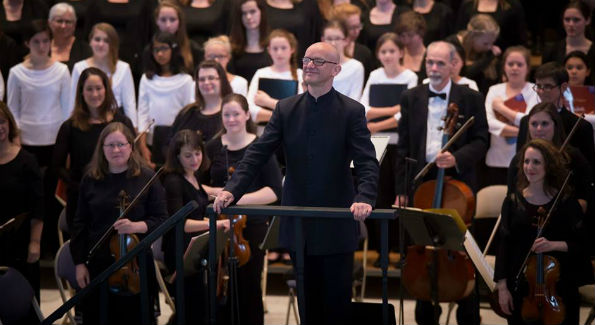The music of Bob Chilcott and William Walton paired well together to create a youthful atmosphere.
By Patrick D. McCoy

Choralis composer in residence Bob Chilcott acknowledges the applause of the audience after the performance of ‘Salisbury Vespers.’ (Photo by Arts Laureate)
Concerts are plentiful in Washington, which has been hailed as the choral capital of the U.S. But what Choralis offered recently in their concert of British composer Bob Chilcott‘s “Salisbury Vespers” and “Belshazzar’s Feast” by William Walton was the marriage of old and new music that added to what was an exciting program.
If other concerts in the city were short on brass players, that is probably because Choralis had the ‘best of the best’ swelling the ranks of the orchestra for both works.
It was certainly a ‘hold on to your hats’ type of musical afternoon. Both Walton’s “Belshazzar’s Feast” conducted by Gretchen Kuhrmann and Chilcott’s “Salisbury Vespers,” which was conducted by Chilcott himself, were large-scale masterpieces that used the full orchestral resources to epic proportions, especially the brass.
First up on the program was “Salisbury Vespers.” As the title implies, the work conjured thoughts of music for a big Gothic cathedral. The spaciousness of National Presbyterian Church served that purpose, and the music was up to the challenge.
There was a wide variety of music in Chilcott’s work. The opening setting of Psalm 69 was undergirded by the full organ, with the voices of the choir particularly punctuated by the brass and timpani.
Balance was an occasional issue, especially in the projection of the voices of the children’s choir, who were often covered by the resonance of the percussion instruments. The repeated ‘Alleluia’ beautifully reinforced the jubilant nature of the movement.
Remarkable contrasts would have to be the trademark of Chilcott’s work. From the crisp, buoyant phrases of the ‘Dixit Dominus’ to the unaccompanied legato lines of the motet “I Sing of a Mayden,” the listener got a sense of a myriad of styles that seemed to inform Chilcott’s journey as a composer.
Though it was is considered one ‘major’ work, Chilcott’s ‘Salisbury Vespers’ is like listening to several mini-masterworks in the context of one performance. Perhaps the crowning achievement of this is the large scale, multi-movement “Magnificat,” which brings the vespers to its end.
The ‘Song of Mary’ extolling praise to God took on new meaning as each phrase was given it’s own musical contrast.
In the ‘Deposuit Potentes,’ the full opening compliment of voices and instruments swelled to a full forte, with a remarkable contrasting section that leaned toward a dark, mysterious sound.
Brass, organ, timpani and the full compliment of strings and winds were the perfect tour de force, bringing the “Salisbury Vespers” to its end.
Maestra Kurhmann took the podium to conduct the mammoth “Belshazzar’s Feast.” Calling for even more musical sources than the Chilcott, it was here that there was a since of comfort in all of that musical power. Opening with the almost summoning nature of the trombone, the men of the choir powerfully sounded forth.
There was such a sense of painting pictures with words, especially on the text “By the Waters of Babylon,” in which the choir sang a beautifully nuanced legato on the word ‘water’ followed by subtle accent on ‘Babylon’ indicating it as a place of importance.
Although instruments can be seen as mere accompaniment to the music, that was not the case with this grand work by William Walton. A feast for instruments and voices alike, Kurhmann gave full attention to all of the musical forces under her baton, which was most evident in here cues to the antiphonal brass and percussion.
The strings and woodwinds were also the full beneficiary of her accuracy. In moments like those, the listener could visually see the contribution of the instrumentalists beyond just accompaniment.
Baritone James Shaffran was a noble, regal presence throughout, like a narrator. Standing high, almost exalted, the best moments came is his solo unaccompanied lines, which allowed the listener to bask in the fullness of his range from top to bottom.
Making superb use of the collegiate voices of the George Mason University Singers and the Cantus Youth Choirs, the collaborative effort added a youthful sparkle to the music that was inherent throughout. Looking to the future through musical lenses of the past, the music of Walton and Chilcott beautifully married together in a program that was a musical feast.
After earning degrees in music from Virginia State University and Shenandoah University, Patrick D. McCoy has contributed arts pieces to CBS Washington and The Afro-American Newspaper, among others. He also writes the magazine’s monthly performing arts column “Perfect Pitch.” McCoy may be reached via email at wlperformingarts@aol.com and on Twitter @PatrickDMcCoy.




